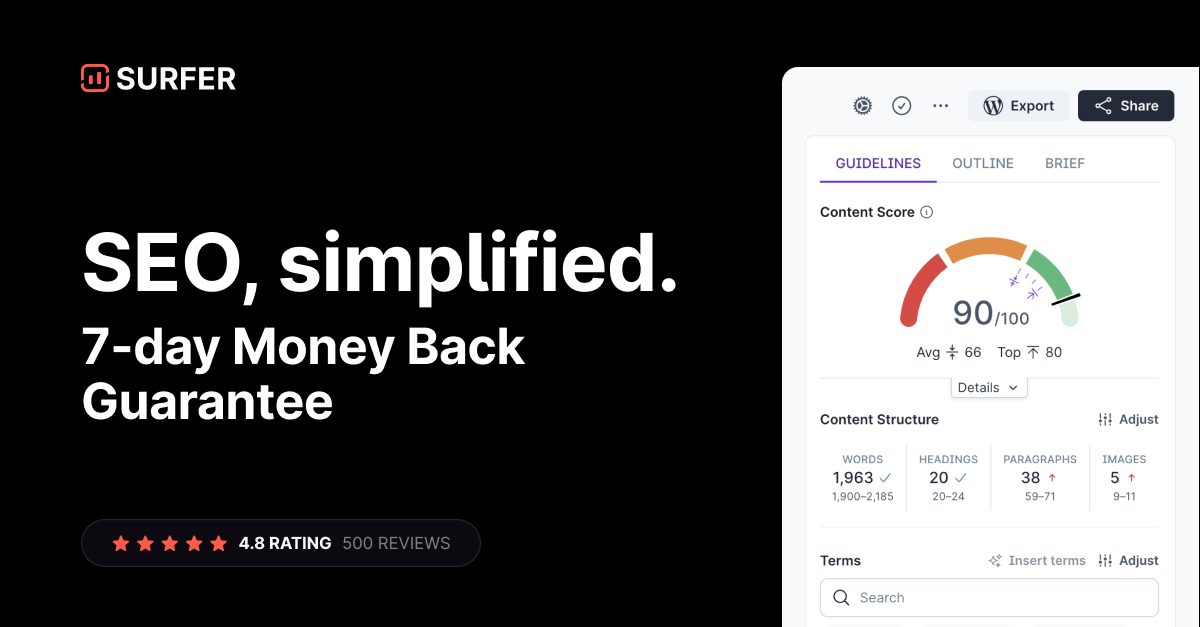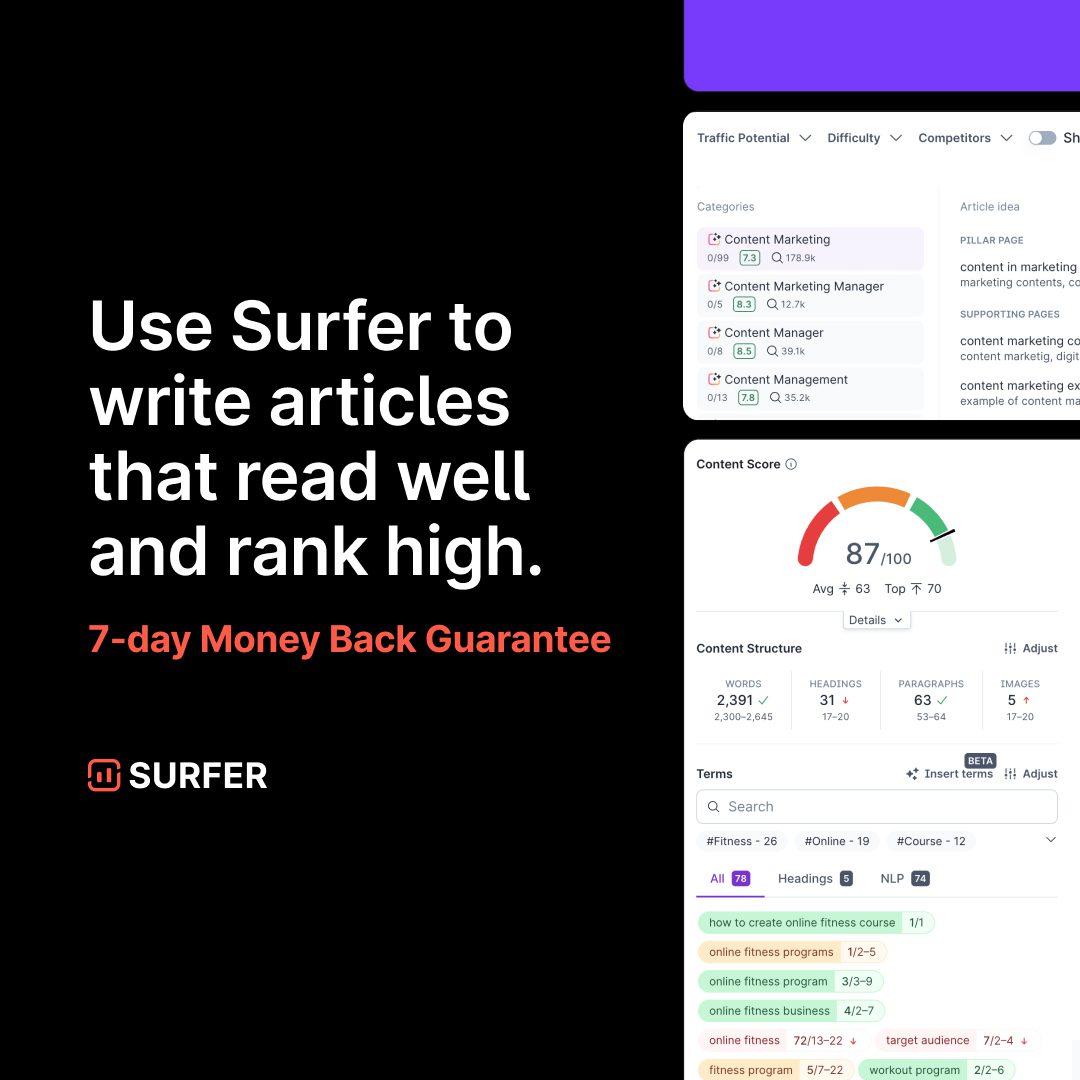Last updated: October 2025
Updated for 2025 pricing & tool features
Surfer SEO has quickly cemented its place as a go-to on-page optimization tool for digital
marketers, business owners, and content creators who demand data-driven results.
This comprehensive guide will teach you how to use Surfer SEO for content optimization-
incorporating both practical workflows and advanced features for 2025.
How to Use Surfer SEO for Content Optimization?
Surfer SEO is a cloud-based content optimization AI that leverages over 500 on-page signals— from word count to NLP-powered entities—to analyze top-ranking pages and generate actionable guidelines for your content.
Its core value? It removes the guesswork from SEO by providing scientific competitor benchmarking, SERP analysis, and real-time content score metrics that even beginners can understand.
As a small business owner myself, I first turned to Surfer SEO when my product pages weren’t ranking despite having great design and unique offers. Within a month of using its Content Editor and Audit tools, my organic traffic rose by nearly 40% (based on my Google Analytics reports). That hands-on improvement made me realize that SEO isn’t magic—it’s about following the right data.
What is Surfer SEO Ideal for?
- SEO copywriters
- Content marketers
- Agencies & teams
- Business owners seeking higher rankings and topical authority
Surfer SEO is more than an optimization platform—it’s a strategic writing companion that helps businesses scale their online visibility through structured, AI-assisted content creation.
Explore Surfer SEO directly hereGetting Started: Setting Up Surfer SEO
Step 1 – Create & Configure Your Account
- Sign up for Surfer SEO and sign in to your dashboard.
- (Optional, but recommended) Connect your Google Search Console. This enables Surfer to give personalized optimization recommendations for your domains.
When I connected my GSC for the first time, I was amazed at how Surfer pulled in actual performance data from my site—it instantly showed which articles needed updates, saving me from endless manual analysis.
Step 2 – Input Your Target Keyword
While Surfer offers a basic keyword analysis tool, most power users supplement this with platforms like Ahrefs or SEMrush for deep keyword discovery before optimizing content in Surfer.
Navigate to the SERP Analyzer. Here, Surfer dissects:
- Word count
- Heading structure (H2s, H3s)
- Keyword frequency
- Use of semantic keywords and LSI terms
- Images, links, and layout cues
This creates a clear blueprint of what works in your niche, showing you the precise on-page elements and AI-backed suggestions necessary for ranking.
Enter your keyword in the Content Editor. Surfer instantly suggests:
- Optimal word length (based on top-ranking pages)
- Related keywords and NLP entities
- Keyword frequency
- A target Content Score (aim for 70+; top performers often reach 80-90)
- H2/H3 paragraph structure
- Recommended media use (images, videos, lists)
Write or paste your draft, and Surfer guides you in real time, flagging where to insert keywords, expand sections, or adjust tone for better performance.
If you’re using ChatGPT alongside Surfer, paste these keywords and structure suggestions into a new prompt. Ask ChatGPT to “write a blog section using these Surfer SEO recommendations in a natural tone.” It’s an effortless way to create optimized copy that still sounds human.
Surfer SEO Workflow Explained
- Keyword Research (Compliment with Other Tools)
- Competitor Analysis
- Content Preparation: Content Editor & Scoring
- SEO Content Audit

1 – Keyword Research
Use tools like Ahrefs or SEMrush to gather high-intent keywords, then feed them into Surfer’s Keyword Research and Clustering modules.
This combination helps small startups identify both main and secondary keywords that build topic authority.
2 – Competitor Analysis
Surfer shows you the top 20 ranking competitors and their metrics:
- Average word count
- Heading structure
- Keyword density
- Related terms
- Internal and external linking patterns
When I analyzed competitors for a “local marketing” article, Surfer revealed that top pages used FAQs and geographic terms far more often. After adding those to my content, my page moved from #17 to #6 in three weeks.
3 – Content Preparation: Content Editor & Scoring
- Aim for a Content Score above 70.
- Include NLP entities and secondary phrases naturally in your text.
- Use Surfer’s sidebar to keep an eye on keyword coverage and section balance.
4 – SEO Content Audit
Already published something? Surfer’s Content Audit software lets you paste your URL and get a customized optimization checklist.
Related Post: Check out our SEO Content Writing Tools guide to learn how Surfer SEO integrates seamlessly with AI tools for faster, optimized content creation.
- Missing semantic terms
- Thin content areas
- Poorly optimized headers
- Internal linking opportunities
Pro Tip: Run audits quarterly or after major Google updates to keep content fresh and competitive.
(Reference: Google Search Central – Creating Helpful, Reliable, People-First Content)
Related Post: Read our detailed review on Affordable CRM Software for Small Businesses — it explains how tools like Surfer SEO and CRMs together streamline marketing workflows.
Surfer SEO Pricing 2025
| Plan | Monthly Price (USD) | Main Features |
|---|---|---|
| Essential | $79 | 360 articles/year, Content Editor, Audit & more |
| Scale | $175 | 1200 articles/year, Topical Map, 3-custom AI templates, SERP analyzer |
| Enterprise | $999+ | SSO, White labeling & API access, Priority support, Rank Tracker, Cannibalization Report & more |
All plans include real-time scoring, SERP analysis, and access to Surfer’s core optimization tools.
For small businesses testing the waters, the Essential Plan is perfect—it provides enough credits to optimize key pages without overspending.
Does Surfer SEO offer a Free Trial?
If you’re wondering whether Surfer SEO offers a free trial, the answer is — not exactly. Surfer doesn’t provide a traditional “free trial” like some tools do. However, you can explore it risk-free through its 7-day money-back guarantee. This allows you to test the platform’s features — including the Content Editor, Audit tool, and SERP Analyzer — and see how they fit your SEO workflow.

Surfer occasionally runs limited-time offers or trial-like promotions, especially for new users or during seasonal campaigns. You can stay updated by subscribing to their newsletter or checking their official pricing page.
If you want to try Surfer before fully committing, start with the Essential Plan, use it for a few days, and if it doesn’t meet your expectations, request a refund within seven days. It’s the most genuine way to experience Surfer’s capabilities without long-term risk.
Feature Comparison: Surfer SEO vs. Alternatives
| Feature | Surfer SEO | SEMrush | Frase |
|---|---|---|---|
| On-page Optimization Tool | Yes | Basic | Yes |
| Content Score Metrics | Yes | No | Yes |
| NLP-powered Optimization | Yes | Partial | Yes |
| Keyword Clustering | Yes | Yes | No |
| SEO Content Audit Software | Yes | Yes | Basic |
| AI Content Writing | Yes | No | Yes |
| GSC Sync | Yes | Yes | No |
| Entry Price / Month | $79* | $129.95* | $44.99* |
Disclaimer: Opinions are based on research and hands-on testing. Pricing and features change; verify details on vendor sites. Some links are affiliate links — at no extra cost to you, I may earn a small commission if you purchase through them. Please read our “Affiliate Disclosure“.
As seen here, Surfer outperforms most tools on real-time optimization, NLP integration, and ease of use for small teams.
Enhancing Your workflow
- Use the Keyword Clustering module for topical authority.
- Integrate Surfer with GSC for focused site-wide recommendations.
- Export suggestions and collaborate with teams for streamlined SEO copywriting workflows.
Pro Tip: Create shared folders in Google Drive and let your writers upload drafts analyzed through Surfer. This keeps collaboration transparent and quality consistent.
Practical Example: Optimizing a Blog Post with Surfer SEO
- Enter your primary keyword into the Content Editor (“How to use Surfer SEO for content optimization”).
- Use Surfer’s Content Audit to analyze top-ranking blogs. Note their use of subheadings (H2/H3), question-based sections, and semantic expansion terms such as “on-page optimization tool” and “SEO copywriting tool.”
- Build your draft following Surfer’s outline: match optimal word count, include recommended related keywords, and monitor your Content Score.
- Fill competitor keyword gaps to improve topical authority.
- Review Surfer’s checklist before publishing: content structure, keyword placement, internal links, and FAQs.
Pro Tips for Optimizing Your Surfer SEO Workflow
- Leverage keyword clustering for wider topical coverage.
- Map competitor keyword gaps and fill them strategically.
- Let Surfer’s AI identify NLP entities and integrate them naturally.
- Use team collaboration features for agency-style coordination.
- Track SERP changes monthly with SERP Analyzer.
If you use ChatGPT for writing, try feeding it Surfer’s “terms to use” list—it will automatically weave those phrases into coherent, human-sounding paragraphs, improving your Content Score fast.
FAQs about Surfer SEO
-
Is Surfer SEO beginner-friendly?
Yes. Surfer offers guided workflows and intuitive scoring; beginners can follow on-screen suggestions with ease.
-
Is Surfer’s keyword tool enough for big campaigns?
It’s solid for quick research, but pair it with Ahrefs or SEMrush for large-scale strategies.
-
What Content Score should I aim for?
Target 70 or higher—most top-ranking content averages 80-90.
-
Can I optimize existing articles?
Absolutely. Use the Audit Tool for rewrite recommendations.
-
Does it support multiple languages?
Yes, making it ideal for international content plans.
-
What’s the main ranking benefit?
Consistent application of data-driven on-page best practices.
Final Thoughts: Should You Try Surfer SEO?
For digital marketers, business owners, and content creators alike, Surfer SEO is a powerful optimization ally. It simplifies content creation, boosts organic visibility, and gives small teams enterprise-level insight.
If you’re running a small business or startup, Surfer SEO can be your secret weapon. Combine it with ChatGPT to write high-quality content fast, then use Surfer’s data to perfect it. That partnership lets you scale without sacrificing authenticity.
To sum it up, Surfer SEO makes data-backed optimization simple for anyone—from solopreneurs to small businesses looking to grow online. Start your journey at SurferSEO, and run your first content audit. You’ll see how data turns intuition into results.






